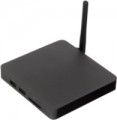AV output
—
AV output. Analogue output for video and audio transferring. Previously, due to the large size of the equipment, it consisted of 3 RCA jacks and was connected to the TV accordingly. Now the devices have become more compact and don't have free space on the case. Therefore, the AV output is a single headphone jack, to which a tee cable is already connected (check availability in the package). Since all components of the video signal are on the same cable, the picture quality and immunity to interference are low.
HDR support
HDR standard supported by the media player.
For more details about HDR in general, see above, while the standard defines some features of the implementation of this feature. Today, the following HDR formats are relevant:
— HDR10. Historically the first of the consumer HDR formats, less advanced than the options described below, but extremely widespread. In particular, HDR10 is supported by almost all streaming services that provide HDR content at all, and it is also common for Blu-ray discs. Allows to work with a colour depth of 10 bits (hence the name). At the same time, devices of this format are also compatible with content in HDR10 +, although its quality will be limited by the capabilities of the original HDR10.
— HDR10+. An improved version of HDR10. With the same colour depth (10 bits), it uses the so-called dynamic metadata, which allows transmitting information about the colour depth not only for groups of several frames, but also for individual frames. This results in an additional improvement in colour reproduction.
—
Dolby Vision. An advanced standard used particularly in professional cinematography. Allows to achieve a colour depth of 12 bits, uses the dynamic metadata described above, and also makes it possible to transmit two image options at once in one video stream — HDR and standard (SDR). At the same time, Dolby Vision is based on the same tec
...hnology as HDR10, so in modern video technology this format is usually combined with HDR10 or HDR10 +. Video decoders
Codec — from the phrase "Encoder-DECoder" — in this case is the format used for encoding digital video during storage/transmission and decoding during playback (without encoding, video data would take up an unjustifiably large amount of space). Do not confuse this parameter with the format of video files: different files of the same format can be encoded with different codecs, and if the corresponding codec is not supported by the player, video playback will be impossible, even if the file format itself corresponds to the capabilities of the device. And in models with online TV support (see "Features") this nuance also determines compatibility with a specific broadcast: the general format of the broadcast is indicated by the codec used for this.
In general, modern devices usually have quite extensive sets of codecs (one of the most advanced is
H.265,
AV1 codecis also popular), and there are usually no problems with video playback; in extreme cases, you can use special programs for transcoding files. As for specific codecs, detailed data on them can be found in special sources, but with standard use of media players, such details are not needed.
Audio decoders
The set of audio codecs supported by the device
Codec — from the phrase "Encoder-DEcoder" — in this case, the format used for encoding and compressing sound in digital form during storage/transmission and decoding — during playback (digital sound is basically impossible without encoding, and compression allows to reduce the amount of data). Information about supported codecs is relevant primarily for assessing whether the player will be able to work with sound in a particular video file. The fact is that even in video files of the same format (see below), sound can be compressed by different codecs; and if the player supports the file format, but does not support the codec, sound playback will become impossible.
Theoretically, these rules are also relevant for audio files and online broadcasts (all formats — TV, video, audio). However, in fact, when working with such content, you can ignore codec data. So, for each audio file format, usually, its own standard codec is used, and file type support automatically means codec support. Broadcasts usually use generally accepted audio decoders like MPEG-1 or MPEG-2, which are practically guaranteed to be supported by any modern player designed for such broadcasts.
As for specific codecs, detailed information on them can be found in special sources, however, with the standard use of devices, such details are usually not needed.
